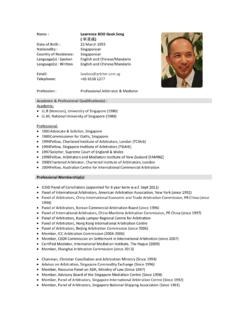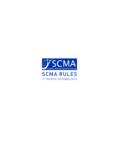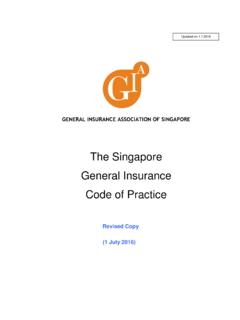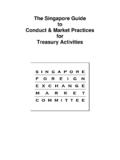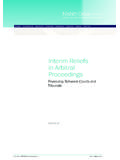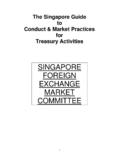Transcription of THE INTERNATIONAL ARBITRATION ACT OF …
1 THE INTERNATIONAL ARBITRATION ACT OF singapore The laws governing private commercial ARBITRATION in singapore are divided into domestic and INTERNATIONAL regimes. There is a third regime that deals with investment disputes, namely the ARBITRATION ( INTERNATIONAL Investment Disputes) Act which gives effect to the United Nations Convention on the Settlement of Disputes between States and Nationals of Other States. I. Background The INTERNATIONAL regime is governed by the INTERNATIONAL ARBITRATION Act (the IAA ), which was enacted in 1994 and was most recently amended in 2012.
2 The IAA gives the force of law to the UNCITRAL Model Law on INTERNATIONAL Commercial ARBITRATION 1985 (the Model Law ), with some modifications. It also gives effect to the New York Convention on the Recognition and Enforcement of Foreign Arbitral Awards 1958 (the New York Convention ).1 singapore adopted the Model Law in 1994 because it was an internationally accepted model. singapore believed that it must adopt a world view of INTERNATIONAL ARBITRATION if it were to be an INTERNATIONAL ARBITRATION It discerned an INTERNATIONAL trend to reduce the extent of curial intervention in ARBITRATION proceedings.
3 The domestic ARBITRATION regime comes under the ARBITRATION Act (the AA ). It was completely revised in 2002 to harmonise the laws relating to domestic ARBITRATION to those governing INTERNATIONAL ARBITRATION . Nonetheless, singapore decided to keep the two regimes separate so that the courts could continue to exercise a greater degree of supervision over domestic 1 An older statute, the ARBITRATION (Foreign Awards) Act, giving effect to the New York Convention is replaced and subsumed within the IAA. 2 Sub-Committee on Review of ARBITRATION Laws, 1993, p.
4 2, para. 8. 3 Review of ARBITRATION Laws, Law Reform and Revision Division, Attorney-General s Chambers, LRRD No. 3/2001, p. vii. 1 Every ARBITRATION in singapore must now be governed by either the AA or the IAA. The IAA applies to INTERNATIONAL arbitrations and defines it in terms comparable (but not identical) to the Model The AA operates as the default regime whenever an ARBITRATION in singapore falls outside the reach of the The AA will also apply where parties to an INTERNATIONAL ARBITRATION which is otherwise subject to the IAA opt out of the IAA.
5 A major difference between the AA and the IAA is the right of appeal from an arbitral award. There is no right of appeal under the IAA but the AA permits an appeal on a question of law, with the leave of the court. Section 49(5) AA incorporates The Nema6 g uidelines which have been followed in In a nutshell, the decision of the arbitral tribunal on the point of law must be obviously wrong, unless it is a question of general public importance in which case the Court must be satisfied that the tribunal s decision is at least open to serious doubt. Under the IAA, the challenges to an award are in the form of an application to set it aside, or to resist enforcement of the award.
6 These are discussed below. II. The INTERNATIONAL ARBITRATION Act The IAA may be seen as a statute incorporating two INTERNATIONAL Conventions: the Model Law and the New York Convention. The IAA consists of four parts. Part I sets out the title provision. Part II is the substantive part on the proceedings of INTERNATIONAL ARBITRATION . The Model Law, with modifications, is made part of singapore law, save for Chapter VIII. Chapter VIII of the Model Law deals with recognition and enforcement of awards. This chapter is not adopted because Part III of the IAA adopts the New York Convention on the enforcement of foreign Lastly, Part IV contains just ancillary provisions binding the Government and allowing for subsidiary legislation.
7 As some details of the Model Law have been modified in the IAA, care must be taken to read the Model Law with Part II of the IAA. 4 Section 5 IAA; cf. Article 1(3) & (4) Model Law. 5 Section 3 AA. 6 Pioneer Shipping v BTP Tioxide Ltd (The Nema) [1982] AC 724. 7 See, Hyundai Engineering v Sembawang Kimtrans [2001] 1 SLR 739; Permasteelisa Pacific Holdings Ltd v Hyundai Engineering and Construction Co Ltd [2005] 2 SLR 270; Engineering Construction Pte Ltd v Sanchoon Builders Pte Ltd [2011] 1 SLR 681. 8 A singapore award may be enforced in the same manner as a judgment of the court: section 19 IAA.
8 2 Application of the IAA The IAA applies automatically if the ARBITRATION is INTERNATIONAL as defined in section 5(2), namely if: (a) at least one of the parties to an ARBITRATION agreement, at the time of the conclusion of the agreement, has its place of business in any State other than singapore ; or (b) one of the following places is situated outside the State in which the parties have their places of business: (i) the place of ARBITRATION if determined in, or pursuant to, the ARBITRATION agreement; (ii) any place where a substantial part of the obligations of the commercial relationship is to be performed or the place with which the subject-matter of the dispute is most closely connected; or (c) the parties have expressly agreed that the subject-matter of the ARBITRATION agreement relates to more than one country.
9 It will also apply if the parties so agree in Conversely, the parties may agree to opt out of the IAA even if the ARBITRATION is INTERNATIONAL in character. Section 15 provides that the mere adoption of institutional rules by parties would not oust the application of the Model Law. Section 15A adds that rules of ARBITRATION adopted by the parties shall apply to the extent that such rules are not inconsistent with the mandatory provisions of the Model Law or the IAA. Enforcing the ARBITRATION agreement The IAA follows the stricter Model Law test for staying of legal proceedings in respect of matters covered by the ARBITRATION agreement, unless the ARBITRATION agreement is null and 9 Section 5(1) of the IAA.
10 3 void, inoperative or incapable of being There are slight differences in the wording. For example, a party who has failed to satisfy the conditions under section 6 IAA for a stay ( before filing pleadings or taking a step in the proceedings) cannot seek a stay under Article 8. Section 7 sets out the court s powers in relation to security obtained for court proceedings, where the proceedings are stayed for ARBITRATION . In the context of an admiralty action, it expressly empowers the court to order that the property arrested be retained as security for the satisfaction of any arbitral award, or that stay of the action be conditional on provision of equivalent security.
